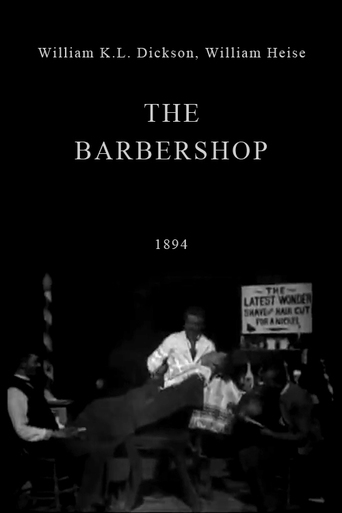cricket crockett
. . . the dangers of second-hand smoke, as the American tobacco industry is one of the first groups to engage in product placement (note the guy with a pipe clenched between his teeth seated stage left of the barber), beaten out only by the liquor guild, which got a bottle of booze horned in to an otherwise innocent BLACKSMITH SCENE filmed slightly earlier in 1893 by the Edison Manufacturing Company. An advertising sign prominently displayed in THE BARBER SHOP 22.4-second short reads "The Latest Wonder: Shave & Hair Cut for a nickel," which, oddly enough, was about the exact same cost of watching SOMEONE ELSE get a shave and hair cut at the kinetograph parlor, which would soon morph into the more aptly named (and easier to pronounce) "nickelodeon." Though this short is set and filmed in the North, it is interesting to note that the barbershop shown is just as segregated (i.e., all-white, in this case) as any in the Jim Crow South would have been in the 1890s.
Brandt Sponseller
This is a 40-second long Edison Company kinetoscope short. Four men play out the scene. One is sitting in a barber's chair getting a shave and a haircut. Another is the barber working on him. The third and fourth flank the barber on either side of the frame, positioned in front of the barber chair and cabinet. The scene actually lasts only 20 seconds, but is repeated in full.Some sources date The Barber Shop to mid-1893 or earlier, and some sources consider it to be "pre-commercial" (that is, prior to an intention for the film to be exhibited commercially on the kinetoscope). While this may indeed be the case, it's unusual in that The Barber Shop is clearly a staged scene; one that is more complex than some of the commercial Edison Company shorts, such as Sandow (1894) and The Cock Fight (1894).This is one of the more successful shorts of the era. While it presents a scene that ostensibly might be an actuality (actualities were something like cinematographic records of everyday scenes), closer examination reveals that the scenario is extremely artificial and directed. For example, there are props that are arranged in exact spots to create maximum effect in the frame of the camera. More notably, each "actor's" motions appear to be precisely planned and directed; they're almost choreographed. The actions provide a fascinating contrapuntal mise-en-scene--each performer is constantly moving, and even inanimate motion is incorporated by way of the smoke from the pipe.The two men flanking the customer stand up at one point and move to the middle of the frame, blocking the view of the barber and customer. All of this complicated motion allows for a repetition that most people do not notice on a first viewing (it took me a couple viewings to notice--I didn't catch it until I switched to a more analytical mode), despite the fact that the man on the left is obviously taking off his coat and hat and sitting down once again. You don't notice because your eye is busy darting around the frame, trying to take all of it in at once.The staging is similar to Glenroy Brothers (Comic Boxing) (1894), but more complex. In the Glenroy Brothers short, the "rear guard" sit motionless, more props than persons. The Barber Shop's approach to creating a "realistic scene" involving a number of people has been much emulated in later films, down to the present, and was subsequently honed artistically to a point that many people no longer noticed the artificiality of the "background action".
someguy889
The Barbershop is another short that I saw on the Landmarks of Early Film DVD. A guy walks up to a barbershop, a man is getting shaved, and another man is there reading the newspaper. The newspaper reading man says something to the waiting man and they both start laughing. Then the shave is done. It lasts about 20 seconds. Then the whole scene is repeated again! The exact same scene. It took me a few seconds to realize that I was watching the same thing twice. Although this short doesn't have the amazing insight and stuff of the Lumiere shorts, and seems much more planned and acted, and the insight into the life in only the most narrow of forms, I thought it was a delightful little short, pointing out the hilarious repititions of every day life. My grade: 7/10
James M. Haugh
Yes those were the days when you could get a shave and a haircut for a nickel (according to the sign behind the barber). This barber shop is on the stage in the Black Maria studio - so called because, to some people, the weird design of this building made them think of a horse-drawn police paddy-wagon that was called a "Black Maria" - at the Edison laboratory. The barber is working on a customer while a man sits screen-right. Another customer enters and sits in a vacant chair screen-left. The man-on-the-right gets up and briefly shows the man-on-the-left something in the newspaper he is holding. All this takes about 20-seconds. Then for some unknown reason, the entire scene is shown over again to produce a 40-second Kinetoscope presentation.
